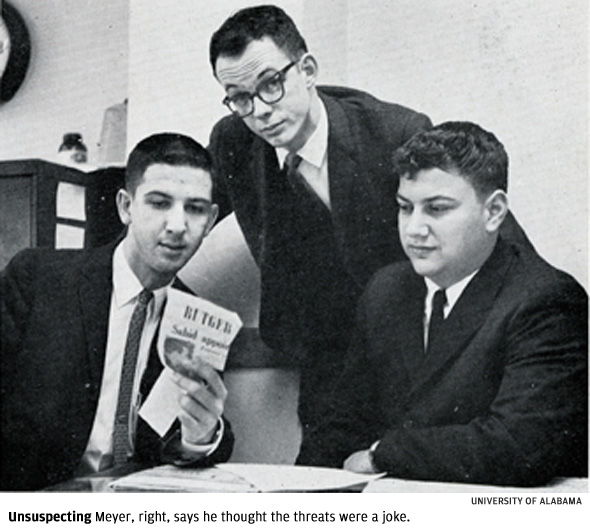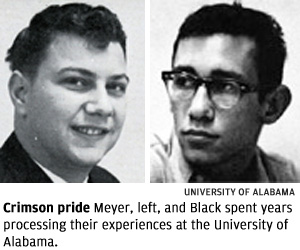
In 1962, the year before the University of Alabama integrated, Melvin Meyer was the 20-year-old editor of the student newspaper, the Crimson White, and Scott Henry “Hank” Black Jr. was his managing editor. In September of that year, they published an editorial calling for the peaceful admission of a black student, James Meredith, to the University of Mississippi, and equal opportunity for blacks generally. Meyer, especially, faced threats and ostracism as a result. The next year, when James Hood and Vivian Malone became the first black students to enroll at Alabama, Black, who had succeeded Meyer as editor, published an editorial by Hood that called for fewer social protests by civil-rights activists and for blacks to focus on attaining education. Hood, who died in January of this year, left school as a result of the uproar that ensued. On the 50th anniversary of Alabama’s integration, journalist Dina Weinstein interviewed Meyer, who is a Sufi teacher in San Francisco, and Black, who is a medical editor at University of Alabama Health Systems, about their experiences. Here are some excerpts:
Melvin Meyer We were not using the newspaper as a political vehicle. Then we published “A Bell Rang” [the pro-integration editorial], and all hell broke loose.
Hank Black As we huddled together in the aftermath, we realized there were threats coming. The university was upset about the stridency, the unilateral sense of the editorial.
Meyer We thought [the threats] were a joke. We were young; we thought everything was kind of funny. We got a lot of hate mail, and we published it to make fun of the grammar, because they were uneducated people. We published them with a lot of ‘sic’ for our own snobbishness. . . . When the Klan burned the cross on my [Jewish] fraternity lawn, I wasn’t even there. The university hired guards to protect me, or spy on me, after that.
Black Mel was frustrated. He realized he was in shackles. The university didn’t want him to cause any trouble that would raise the specter of violence when the university was integrated.

Meyer We had to drive to Birmingham every week to print the newspaper. The university got the printer to notify them if there were any articles that were possibly incendiary. . . . I didn’t see myself as an activist. I was an outsider. Being a Jew at the University of Alabama in 1963 made you different and suspect.
Probably the biggest way the experience affected me was in the deepening of my heart’s feeling nature, and thus finding deeper empathy and relationship with people whom I had never thought too much about before. . . . The experience of expanding my interest and empathy continued. The outer identity as a social-justice figure quickly gave way to the role of student of philosophy and comparative religion, and from there into absorption in mysticism, the continual longing for the Beloved and the union in the Beloved, and then deeper study and discipleship with a Sufi Master.
Black My year [as editor] was as monumentally frightening, but also as important to the university, as I could have imagined. I was terrified about how to handle the responsibilities of editorship during the days of [Governor George C. Wallace’s] Schoolhouse Door Stand. It made me realize that very few people understand what to do in moments of crisis and historic change, but that somehow, someday we just have to jump in and do what we can and not flay ourselves about hesitation and procrastination–and cowardice, even.
I always was the beneficiary of some gravitas due to my participation in and perspective on the integration, but up until the past few years I did not value it as much as I do now. I accept that I played a small part in the burning issues of my youth and do not minimize it. As scared as I was, I at least accepted the task and completed it; that acceptance was a significant part of my life’s work.
Dina Weinstein is a Miami, Florida-based journalist and graduate of the Columbia University Graduate School of Journalism. She is researching the life of cartoonist and author Syd Hoff.
